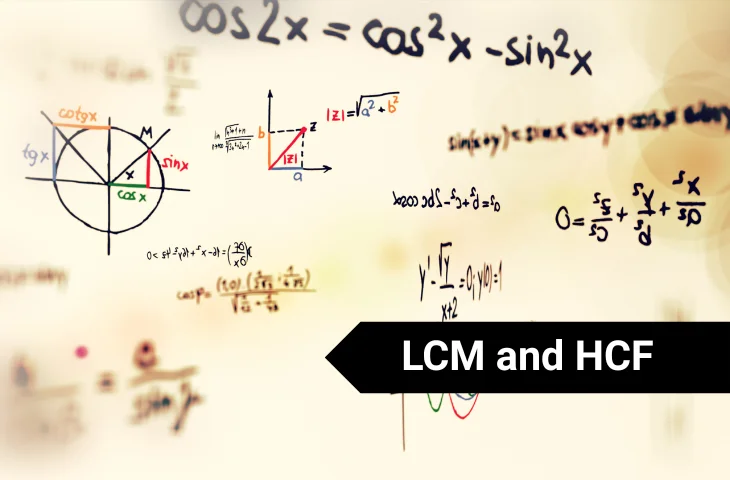LCM (Least Common Multiple) and HCF (Highest Common Factor) form the backbone of many Quantitative Aptitude questions in SSC, Banking, and RRB exams. This topic is tested directly as well as indirectly in problems related to time, work, trains, pipes, and ratios. In this blog, we have provided all the details including definitions of LCM and HCF, short notes, formulas, tricks, solved questions, and more.
What Is LCM and HCF in Quantitative Aptitude?
- LCM (Least Common Multiple): The smallest number that is a multiple of two or more numbers.
- HCF (Highest Common Factor): The largest number that divides two or more numbers exactly.
Why it appears in exams:
- LCM-HCF is widely used in time-related problems, divisibility, fractions, and word problems.
- Examiners use it to check a candidate’s ability to apply number system logic quickly.
Skills required:
- Factorization method
- Prime numbers identification
- Divisibility rules
- Logical elimination
Why Is LCM and HCF Important in Competitive Exams?
In almost every competitive exam, at least one question is asked from LCM and HCF. Since the topic is concept-based, candidates who revise formulas and tricks can solve these questions in under 30 seconds.
| Exam | No. of Questions | Difficulty |
| SSC CGL / CHSL | 1–2 | Easy |
| IBPS PO / SBI PO | 1–2 | Moderate |
| RRB NTPC / Group D | 1 | Easy |
| State PSC / Police | 1–2 | Moderate |
LCM and HCF Quantitative Aptitude Short Notes
Before solving exam questions, revise these quick points:
| Term | Meaning | Example |
| LCM | Smallest multiple of given numbers | LCM of 4, 6 = 12 |
| HCF | Greatest divisor of given numbers | HCF of 12, 18 = 6 |
| Product Rule | HCF × LCM = Product of Numbers (for two numbers) | For 12, 18 → HCF=6, LCM=36 → 6×36=12×18 |
| Prime Factorization | Method of finding HCF & LCM using prime numbers | 12=2²×3, 18=2×3² |
| Division Method | Step-wise division to find HCF | Applied to 42 and 56 → HCF=14 |
What Are the Types of LCM and HCF Questions in Quantitative Aptitude?
In competitive exams, questions are framed in different ways:
- Direct Questions – Find LCM/HCF of two or more numbers.
- Word Problems – Based on time, work, and periodic events.
- Application-Based – Problems involving pipes, trains, or bells ringing.
- Mixed Concept – Combined with ratio, percentages, or algebra.
LCM and HCF Formulas for Quantitative Aptitude
The formulas to calculate the LCM and HCF of a given set of numbers are as follows:
- HCF × LCM = Product of Numbers (for 2 numbers)
- HCF of fractions = HCF of numerators ÷ LCM of denominators
- LCM of fractions = LCM of numerators ÷ HCF of denominators
- If two numbers are coprime – HCF = 1, LCM = Product of numbers
- LCM (a, b, c) = Smallest number divisible by all three
LCM and HCF Tricks for SSC CGL and Other Exams
Tricks to solve questions based on LCM and HCF are as follows:
- Always start with prime factorization for speed.
- Use the product rule to check accuracy.
- For word problems, identify if it is asking meeting time (LCM) or division problem (HCF).
- Eliminate options using divisibility rules.
- For large numbers, use the division method instead of factorization.
Solved LCM and HCF Questions from 2024–25 Exams
Question 1 (SSC CGL 2024 Tier 1 – Memory Based):
Find the LCM and HCF of 12 and 18.
- Solution: 12 = 2²×3, 18 = 2×3²
- HCF = 2×3 = 6
- LCM = 2²×3² = 36
- Check → 6×36 = 12×18
Question 2 (IBPS PO Prelims 2024 – Based on Mock):
The product of two numbers is 180. If HCF is 6, find the LCM.
- Solution: Product = HCF × LCM – 180 = 6 × LCM – LCM = 30.
Question 3 (RRB NTPC 2024 – Memory Based):
Three bells ring at intervals of 15, 20, and 30 seconds. After how many seconds will they ring together?
- Solution: LCM(15, 20, 30) = 60 – Answer: 60 seconds.
LCM and HCF Concepts for Bank Exams
Banking exams often use application-based word problems rather than direct calculation. For example:
Example (SBI PO Mains 2024 – Mock):
A, B, and C can complete a task in 12, 15, and 20 days respectively. After how many days will they complete a task together if they start on the same day?
- This is solved using LCM = 60 days (total work) – then unit work method.
Common Mistakes to Avoid while Solving LCM and HCF
Some of the common mistakes aspirants must avoid while solving questions based on LCM and HCF are as follows:
- Confusing LCM with HCF – LCM ≥ greatest number, HCF ≤ smallest number.
- Forgetting the product rule for cross-check.
- Using wrong prime factorization.
- Skipping word problem translation (e.g., bells, trains).
- Ignoring fraction formulas in exams.
FAQs
Use prime factorization or product rule.
LCM = LCM of numerators ÷ HCF of denominators.
HCF = HCF of numerators ÷ LCM of denominators.
Numbers with HCF = 1.
Direct, word-based, application, and mixed concept.
- PNB LBO Syllabus and Exam Pattern 2025, Check Details
- PNB LBO Salary 2025, Pay Scale, Perks and Benefits
- SBI CBO Final Result 2025 Out, Download Final Selection PDF
- IBPS RRB PO Exam Analysis 2025, All Day, All Shifts
- 100 Shortcut & Trick Questions Compilation for SSC CHSL
- Most Repeated English Questions for SSC CHSL Tier 2

Hi, I’m Aditi. I work as a Content Writer at Oliveboard, where I have been simplifying exam-related content for the past 4 years. I create clear and easy-to-understand guides for JAIIB, CAIIB, and UGC exams. My work includes breaking down notifications, admit cards, and exam updates, as well as preparing study plans and subject-wise strategies.
My goal is to support working professionals in managing their exam preparation alongside a full-time job and to help them achieve career growth.
